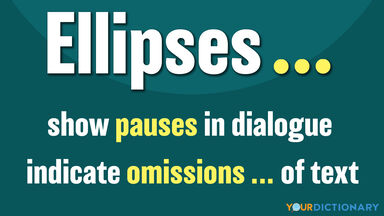What Is An Ellipse In Writing
How to Use Ellipses: Demystifying the Purpose
What are ellipses? An ellipsis (...) is a punctuation mark that consists of three dots or periods (ellipses is the plural form of ellipsis). You probably see ellipses everywhere, including text messages, emails and social networking. However, the ellipsis serves a particular use in both formal and informal styles of writing. Try following some of these simple guidelines as to when ellipses should be used — and when they should not.
 ellipses example definition
ellipses example definition
When Should You Use Ellipses?
Knowing when to use ellipses and how to use ellipses is one of the Common Core state standards for eighth grade language. The two main purposes of ellipses in text are:
-
indicating an omission within a piece of text
-
showing a pause in a character's dialogue (or "trailing off" at the end of dialogue)
According to the MLA and Chicago manuals of style, an ellipsis is three periods with a space in between each [ . . . ] and a space before and after the ellipsis. The AP style guide prefers three dots with no spaces in between [ ... ], and others prefer the auto-formatted version of the ellipsis, with less than a full space in between each dot […].
Using Ellipses for Omission in News Reports
News reports compile information to present to the population. Sometimes when a news report includes a quote, parts of the quote are unnecessary to the story. An ellipsis can replace this unnecessary part of the quote. For example, if a fire broke out and a fire chief gave the following quote, most of the quote would likely be considered unnecessary:
-
without an ellipsis - "We've determined positively, absolutely, beyond the shadow of a doubt, drawing our conclusions from all the available data, understanding the impact of the recent spate of arsons, that this fire was accidental."
-
with an ellipsis - "We've determined positively … that this fire was accidental."
Readers get the same idea in a shorter amount of time with the second sentence. The newspaper saves valuable space for more information, and the readers don't need to spend time with unnecessary wording.
Using Ellipses for Omission in Formal Writing
The same rule applies to formal writing, such as academic papers and published research, when a quote might be too long or clunky. For example, a discussion of search and seizure might invoke part of the Fourth Amendment, but not all of it:
-
without an ellipsis - "The right of the people to be secure in their persons, houses, papers, and effects, against unreasonable searches and seizures, shall not be violated, and no Warrants shall issue, but upon probable cause, supported by Oath or affirmation, and particularly describing the place to be searched, and the persons or things to be seized."
-
with an ellipsis - "The right of the people to be secure … against unreasonable searches and seizures, shall not be violated …."
Notice that if a sentence ends with an ellipsis, a final period is included for clarity. It shows that there is more to the quote, but it may not be relevant to the point.
Using Ellipses to Show Pauses in Dialogue
Stories and novels use ellipses to a very different effect. An ellipsis can demonstrate a pause in dialogue or a character "trailing off" (stopping talking without finishing their sentence). Examples of ellipses in fiction include:
-
He stammered, "Please ... tell my son ... that I love him ..."
-
My mother put the phone to her ear. "Hello? ... Yes, this is Kay ... no, I'm not interested in a subscription ..."
-
"Are you ... are you serious?"
-
"I've been wondering ... and I hope you agree ... that we should be married."
Notice that each of these ellipses adds to the quotation's style. Longer pauses show that the character is speaking in a drawn-out way, while ellipses at the end of quotes show that the character has trailed off.
When Shouldn't You Use Ellipses?
An ellipsis can be a very effective punctuation tool. However, when ellipses are overused or used incorrectly, they can make writing feel plodding. Avoid using ellipses in the following situations:
- to indicate a pause in narration (use a comma instead)
- instead of "um" in narration (create new, full sentences instead)
- to cut out most of an important quotation (choose a more specific quotation instead)
- trailing off unnecessarily (end the sentence unless the character really is trailing off)
The main rule of ellipses is not to overuse them. When in doubt, find a different way to write your sentence to avoid the ellipsis unless you know exactly why you're using it. Also, never use more than three periods as an ellipsis, even when indicating a longer pause or omission: ellipses always have three periods, no matter the style guide.
Use a Consistent Style
Ellipses are a writing convention that add to a writer's style but are not entirely necessary for getting your point across. They should only be used to indicate omissions or dialogue pauses, so if you're tempted to use them in other ways, double-check which punctuation mark might be a better choice. Refresh your knowledge on colons, semicolons and dashes while you're learning about interesting ways to vary your writing style.
What Is An Ellipse In Writing
Source: https://grammar.yourdictionary.com/punctuation/when-to-use-ellipses.html
Posted by: hutchesonmationdeed.blogspot.com

0 Response to "What Is An Ellipse In Writing"
Post a Comment